Ab75 Late 1960s San Francisco Politics Arts and Culture Full Film

The culture of Indonesia has been shaped by long interaction between original indigenous community and multiple foreign influences. Indonesia is centrally-located along ancient trading routes between the Far Due east, Southern asia and the Middle Due east, resulting in many cultural practices being strongly influenced by a multitude of religions, including Buddhism, Christianity, Confucianism, Hinduism, and Islam, all strong in the major trading cities. The issue is a complex cultural mixture, often different from the original indigenous cultures.
Examples of the fusion of Islam with Hinduism include Javanese Abangan belief. Balinese dances take stories about ancient Buddhist and Hindu kingdoms, while Islamic art forms and architecture are present in Sumatra, especially in the Minangkabau and Aceh regions. Traditional art, music and sport are combined in a martial art class chosen Pencak Silat.
The Western world has influenced Republic of indonesia in scientific discipline, technology and modern amusement such as idiot box shows, film and music, as well as political system and issues. Bharat has notably influenced Indonesian songs and movies. A popular type of song is the Indian-rhythmical dangdut, which is frequently mixed with Arab and Malay folk music.
Despite the influences of strange culture, some remote Indonesian regions still preserve uniquely indigenous culture. Indigenous ethnic groups Mentawai, Asmat, Dani, Dayak, Toraja and many others are however practising their ethnic rituals, community and wearing traditional clothes.[one]
Traditional performing arts [edit]
Music [edit]

Republic of indonesia is habitation to with those from the islands of Java, Sumatra and Bali being oftentimes recorded. The traditional music of West, Central, and East Java and Bali is the gamelan (traditional instruments include: gambang, bonang, saron, kenong, gong, and many more). Gamelan is recognized equally a Masterpiece of the Oral and Intangible Heritage of Humanity by UNESCO (United nations Educational, Scientific and Cultural Organization).
On 29 June 1965, Koes Plus, a leading Indonesian pop group in the 1960s, 1970s and 1980s, was imprisoned in Glodok, W Dki jakarta, for playing Western-style music. Subsequently the resignation of President Sukarno, the law was rescinded, and in the 1970s the Glodok prison house was dismantled and replaced with a large shopping mall.
Kroncong is a musical genre that uses guitars and ukulele as the master musical instruments. This genre had its roots in Portugal and was introduced by Portuguese traders in the 15th century. There is a traditional Keroncong Tugu music grouping in North Jakarta and other traditional Keroncong music groups in Maluku, with strong Portuguese influences. This music genre was popular in the first one-half of the 20th century; a contemporary form of Kroncong is called Popular Kroncong.
Angklung musical orchestra, native of West Coffee, received international recognition as UNESCO has listed the traditional W Java musical instrument fabricated from bamboo in the list of intangible cultural heritage.[2] [3]
The soft Sasando music from the province of Eastward Nusa Tenggara in Due west Timor is completely different. Sasando uses an instrument fabricated from a separate leafage of the Lontar palm (Borassus flabellifer), which bears some resemblance to a harp.
- Some examples of Indonesian traditional music instruments
Dance [edit]

Indonesian trip the light fantastic toe reflects the diverseness of civilization from indigenous groups that composed the nation of Indonesia. Austronesian roots and Melanesian tribal trip the light fantastic forms are visible, and influences ranging from neighbouring Asian countries; such as India, Mainland china, and Middle East to European western styles through colonization. Each ethnic grouping has its own distinct dances; makes total dances in Republic of indonesia are more than 3000 Indonesian original dances. However, the dances of Indonesia tin be divided into 3 eras; the Prehistoric Era, the Hindu/Buddhist Era, and the Era of Islam, and into two genres; court dance and folk dance.
There is a continuum in the traditional dances depicting episodes from the Ramayana and Mahabharata from India, ranging through Thailand, all the way to Bali. In that location is a marked difference, though, between the highly stylized dances of the courts of Yogyakarta and Surakarta and their popular variations. While the court dances are promoted and fifty-fifty performed internationally, the popular forms of dance art and drama must largely be discovered locally.

Reog Ponorogo is besides a dance that originated from the district Ponorogo, Due east Java, which is a visualization of the legendary story Wengker kingdom and the kingdom of Kediri.
A popular line dance called Poco-poco was originated in Indonesia and besides pop in Malaysia, just at early Apr 2011 Malaysian Islamic clerics banned the poco-poco dance for Muslims due to them believing it is traditionally a Christian dance and that its steps brand the sign of the cantankerous.[4]
During the Intergovernmental Committee for the Safeguarding of the Intangible Cultural Heritage convention in 29 November to 4 December 2015 in Windhoek, Namibia, UNESCO recognizes 3 genres of traditional dance in Bali, Indonesia, every bit Intangible cultural heritage.[five] The three genres includes Wali (sacred dances), Bebali (semi-sacred dances) and Balih-balihan (dances for entertainment purposes). Balinese dance has been proposed since 2011,[6] and officially recognized in 2015.
Previously, on 24 Nov, 2011, UNESCO officially recognized Aceh'due south traditional Saman trip the light fantastic toe as an Intangible Cultural Heritage in Need of Urgent Safeguarding.[7] [8] [9]
- Some examples of Indonesian Traditional trip the light fantastic toe
-
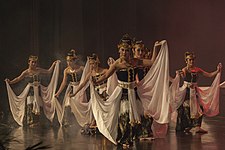
-
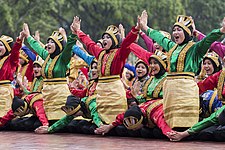
Drama and theatre [edit]

The Wayang show, the Javanese, Sundanese, and Balinese shadow boob theatre shows display several mythological legends such as Ramayana, Mahabharata, and many more. Wayang Orang is a Javanese traditional dance drama based on wayang stories. Various Balinese trip the light fantastic drama besides can exist included inside the traditional course of Indonesian drama. Another form of local drama is Javanese Ludruk and Ketoprak, Sundanese Sandiwara, and Betawi Lenong. All of these dramas incorporated humour and jest, oftentimes involving audiences in their performance.
The shadow puppets are mostly made of sheets of sure items. You tin can make yours using wax newspaper and a sheet of translucent plastic, and download templates only those people really exercise have the talent to arts and crafts their own and ane-of-a-kind shadow puppets, which are carved ane by one segment out of metal or other special materials.[10] [xi]
UNESCO designated Wayang the flat leather shadow boob (wayang kulit) and the three-dimensional wooden boob (wayang golek or wayang klitik) theatre, as a Masterpiece of the Oral and Intangible Heritage of Humanity on seven Nov 2003. In render for the acknowledgement, UNESCO required Indonesians to preserve the tradition.[12]
Randai is a folk theatre tradition of the Minangkabau people of Westward Sumatra, unremarkably performed for traditional ceremonies and festivals. It incorporates music, singing, dance, drama and the silat martial art, with performances often based on semi-historical Minangkabau legends and love story.
Bangsawan is a Malay folk theatre institute in the province of Riau.
Mod performing fine art also adult in Indonesia with its distinct style of drama. Notable theatre, trip the light fantastic toe, and drama troupe such as Teater Koma are gaining popularity in Indonesia as their drama often portray social and political satires of Indonesian society.[13]
- Some examples of Indonesian Dance Drama and Theatre
-

Wayang Kulit (Leather shadow puppet) Performance in Java
Martial arts [edit]
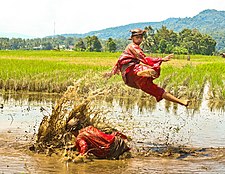
The fine art of Pencak Silat was created and firstly developed in the islands of Java and Sumatra.[xiv] It is an fine art for survival and practised throughout the Indonesian archipelago. Centuries of tribal wars in Indonesian history had shaped silat as it was used by the ancient warriors of Indonesia. Silat was used to decide the rank and position of warriors in quondam Indonesian kingdoms.
Pencak Silat is recognized as a Masterpiece of the Oral and Intangible Heritage of Humanity by UNESCO (Un Educational, Scientific and Cultural Organisation) on 12 December 2019.[15]
Contacts with Indians and Chinese has further enriched silat. Silat reached areas beyond Indonesia mainly through the diaspora of Indonesian people. People from diverse regions like Aceh, Minangkabau, Riau, Bugis, Makassar, Java, Banjar, etc. moved into and settled in Malay Peninsula and other islands. They brought silat and passed information technology down to their descendants. The Indonesian of half-Dutch descent are likewise credited as the kickoff to accept brought the art into Europe.
Silat was used past Indonesian independence fighters during their struggle against the Dutch colonial dominion. Unfortunately, after Indonesia achieving their independence, silat became less popular among Indonesian youth compare to foreign martial arts like Karate and Taekwondo. This probably because silat was not taught openly and merely passed down amidst blood relatives, the other reason is the lack of media portrayal of the art.
Efforts have been made to introduce and reintroduce the beauty of silat to Indonesian youth and the earth. Exhibitions and promotions past individuals every bit well as state-sponsored groups helped the growing of silat'south popularity, specially in Europe and The states. Indonesian 2009 Silat movie Merantau is i of Indonesian efforts to introduce silat to the international scene.
Another martial art from Indonesia is Tarung Derajat. It is a modern combat system created by Haji Ahmad Drajat based on his experience as a street fighter. Tarung Drajat has been best-selling equally a national sport by KONI in 1998 and is now used by Indonesian Army as role of their basic training.[16]
In Eastern Republic of indonesia, there is a type of martial art hitting with a whip or stick. Caci is a course of fighting with a whip or stick. It appears to exist indigenous to Flores in East Nusa Tenggara, only it is also practised in Bali and Lombok.
- Some examples of Martial arts in Indonesia
Traditional visual arts [edit]
Painting [edit]
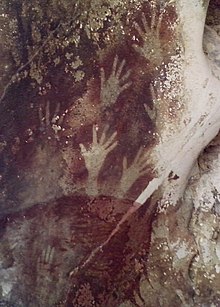
I of the oldest cave paintings in the world dating back more than than 44,000 years old (art of the Upper Paleolithic), was found in caves in caves in the district of Maros (Sulawesi, Republic of indonesia). The oldest types of cave painting are mitt stencils and simple geometric shapes.[17]
In 2018, scientists reported the discovery of the and then-oldest known figurative fine art painting, over 40,000 (peradventure equally old as 52,000) years old, of an unknown animal, in the cave of Lubang Jeriji Saléh on the Indonesian island of Borneo. In December 2019, however, figurative cave paintings depicting sus scrofa hunting in the Maros-Pangkep karst in Sulawesi were estimated to be even older, at at least 43,900 years quondam. The finding was noted to exist "the oldest pictorial record of storytelling and the earliest figurative artwork in the world".[18] [19]

Kamasan Palindon Painting detail, an example of Kamasan-fashion classical painting
Indonesian painting before the 19th century is more often than not restricted to the decorative arts, considered to be a religious and spiritual activity, comparable to the pre-1400 European art. Artists' names are anonymous since the private human creator was seen as far less of import than their creation to accolade the deities or spirits. Some examples are the Kenyah decorative art, based on endemic natural motifs such as ferns and hornbills, found decorating the walls of Kenyah longhouses. Another notable traditional art is the geometric Toraja wood carvings. Balinese paintings are initially the narrative images to describe scenes of Balinese legends and religious scripts. The classical Balinese paintings are oft decorating the lontar manuscripts and also the ceilings of temples pavilion.
Under the influence of the Dutch colonial power, a tendency toward Western-style painting emerged in the 19th century. In the Netherlands, the term "Indonesian Painting" is practical to the paintings produced by Dutch or other foreign artists who lived and worked in the former Netherlands-Indies. The about famous indigenous 19th-century Indonesian painter is Raden Saleh (1807–1877), the first indigenous artist to report in Europe. His art is heavily influenced past Romanticism.[20] In the 1920s Walter Spies settled in Bali, he is often credited with alluring the attention of Western cultural figures to Balinese culture and art. His works accept somehow influenced Balinese artists and painters. Today Bali has i of the most vivid and richest painting traditions in Indonesia.
The 1920s to 1940s were a time of growing nationalism in Indonesia. The previous menses of the romanticism movement was not seen as a purely Indonesian movement and did not develop. Painters began to see the natural world for inspiration. Some examples of Indonesian painter during this menses are the Balinese Ida Bagus Made and the realist Basuki Abdullah. The Indonesian Painters Association (Persatuan Ahli-Ahli Gambar Republic of indonesia or PERSAGI, 1938–1942) was formed during this flow. PERSAGI established a contemporary art philosophy that saw artworks equally reflections of the artist's private or personal view as well as an expression of national cultural thoughts.[21] [22]
- Some examples of Indonesian painting
-
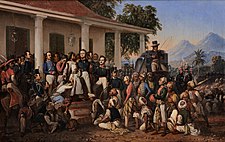
-
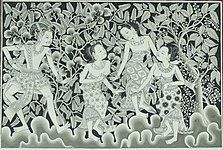
Modern painting of Prince Panji coming together iii women in the jungle
Woods carvings [edit]

The fine art of wood etching is quite well-developed in Indonesia. Other than tribal art woodcarvings of Asmat, Batak, Dayak, Nias, and Toraja expanse is well known for its refined forest carving culture; they are Jepara in Central Java and Bali. Mas village near Ubud in Bali is renowned for its wood carving art. Balinese woodcarving today has a sustained tourist market in Bali.
In Papua, asmat art consists of elaborate stylized wood carvings such equally the bisj pole and is designed to honour ancestors. Many Asmat artefacts have been collected by the earth's museums, among the most notable of which are those found in the Michael C. Rockefeller Drove at the Metropolitan Museum of Art in New York City and the Tropenmuseum in Amsterdam. Bisj poles are carved by Asmat religious carvers (wow-ipits) afterward a member of their tribe or community had been killed and headhunted past an enemy tribe. Carved out of a single slice of a wild mangrove tree, Bisj poles can reach heights of up to 25 feet (vii.62 yard). Their carvings depict homo figures standing on superlative of each other, as well equally animal figures, phallic symbols, and carvings in the shape of a canoe prow. The Asmat participated in headhunting raids and cannibalism as rituals, many rituals involved the Bisj poles, including dancing, masquerading, singing and headhunting—all performed by men.

The Nias adu zatua (wooden antecedent statues)
In North Sumatra, the people of Nias placed great value on wooden figures or adu. The sole purpose of the Nias figures was to fulfil ritual needs, whether it is to ensure wealth or to perform specific benign rite. Niassan figures vary in size, from every bit small as twenty centimetres (7.9 in) in top to more than than two metres (6.six ft) alpine. When an elderly person died, the family would make a wooden statue known equally adu zatua. The statue was unveiled on the quaternary 24-hour interval after the death of the person. The shape of the wooden statue reflects the status of the person who used them: the more powerful the owner, the more impressive the statue will be fabricated. Nias people believed that the deceased person's spirits reside in the statue, and then all events that occurred in the family unit were shared with the antecedent statues through prayers. Ancestor statues were placed in the principal room of the firm, sometimes more than than a hundred. A missionary work in 1930 had recorded the removal of 'over 2000 "idols" from a house of new northern catechumen.' Some missionaries even recorded houses collapsing under the weight of these ancestor figures. Small adu zatua were bound together horizontally using a rattan and pegs.
Many ancestor figures were destroyed in 1916 by Christian missionary movements which saw them every bit an one-time blasphemous religious symbol. Some were sold to collectors and can be found in museum or individual collections around the world.
In Sulawesi, Torajans carve forest, calling information technology Pa'ssura (or "the writing"). One of the Toraja wood carvings is Tau tau, Tau tau is a kind of homo statue fabricated of wood or bamboo. Torajans believe that the dead tin take their possessions with them to the afterlife, the effigies are usually equipped with modest possessions. Traditionally, the effigies were but carved, only to testify the gender of the deceased. All the same, they have get more than and more elaborate, really attempting to imitate the likeness of the deceased. Nowadays, Tau tau has a photographic likeness to the people they represent.
- Some examples of Indonesian wood etching for rituals
-
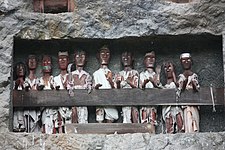
Toraja stone-carved burying site. Tau tau (wooden statue of the deceased) were put in the cave, looking out over the land, in Due south Sulawesi
-
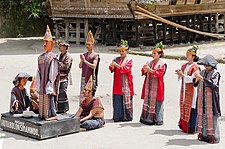
-
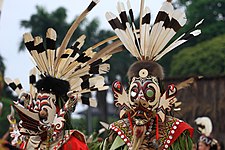
Sculpture [edit]

Republic of indonesia has a long history of rock, bronze and Atomic number 26 Ages arts. Indonesia has a rich history of Hindu–Buddhist sculpture and compages that has been shaped past a complex fusion of local, indigenous culture combined with foreign customs. Some Indonesian artifacts made from gold and bronze dating back to the tenth century are exhibited in the US.[23] The megalithic sculptures tin be constitute in numerous archaeological sites in Sumatra, Java to Sulawesi. The native Indonesians tribes have their own distinct tribal sculpture styles, usually created to depict ancestors, deities and animals. The rock sculpture artform particularly flourished in 8th-to-10th-century Coffee and Bali, which demonstrate the influences of Hindu-Buddhist culture, both as stand-alone works of art and also incorporated into temples. The most notable sculpture of the classical Hindu-Buddhist era of Indonesia are the hundreds of meters of relief and hundreds of stone buddhas at the temple of Borobudur in central Java. Approximately ii miles of exquisite relief sculpture tell the story of the life of Buddha and illustrate his teachings. The temple was originally domicile to 504 statues of the seated Buddha. This site, equally with others in central Java, show a articulate Indian influence.

The examples of notable Indonesian Hindu-Buddhist sculptures are; the statues of Hindu deities; Shiva, Vishnu, Brahma, Durga, Ganesha and Agastya enthroned in rooms of Prambanan temples, the Vishnu mounting Garuda statue of king Airlangga, the exquisite statue of Eastern Javanese Prajnaparamita and 3.seven meters tall Dvarapala dated from Singhasari menstruation, and also the chiliad statue of Bhairava Adityawarman discovered in Sumatra. Today, the Hindu-Buddhist style stone sculptures are reproduced in villages in Muntilan most Borobudur too in Trowulan the former capital site of Majapahit in East Java, and Bali, and sold as a garden or pool ornament statues for homes, offices and hotels.
The walls of candi also frequently displayed bas-reliefs, either serve equally decorative elements also as to convey religious symbolic meanings; through describing narrative bas-reliefs. The nigh exquisite of the temple bas-reliefs can exist found in Hindu and Buddhist temples. The first four terraces of Borobudur walls are showcases for bas-relief sculptures. These are exquisite, considered to be the most elegant and graceful in the ancient Buddhist world.[24] The Buddhist scriptures describes as bas-reliefs in Borobudur such as Karmavibhangga (the law of karma), Lalitavistara (the birth of Buddha), Jataka, Avadana and Gandavyuha. While in Prambanan the Hindu scriptures is describes in its bas-relief panels; the Ramayana and Bhagavata Purana (popularly known as Krishnayana).
The bas-reliefs in Borobudur depicted many scenes of daily life in 8th-century ancient Java, from the courtly palace life, hermit in the forest, to those of commoners in the village. It also depicted a temple, marketplace, diverse flora and fauna, and also native vernacular architecture. People depicted here are the images of king, queen, princes, noblemen, courtier, soldier, servant, commoners, priest and hermit. The reliefs as well depicted mythical spiritual beings in Buddhist beliefs such as asuras, gods, boddhisattvas, kinnaras, gandharvas and apsaras. The images depicted on bas-relief oftentimes served as a reference for historians to inquiry sure subjects, such as the study of compages, weaponry, economy, style, and likewise the mode of transportation of eighth-century Maritime Southeast Asia. One of the famous renderings of an 8th-century Southeast Asian double outrigger ship is Borobudur Transport.
- Some examples of Indonesian Statues and Reliefs
Architecture [edit]

For centuries, Indonesian vernacular architecture has shaped settlements in Indonesia which normally took the form of timber structures built on stilts dominated past a large roof. The most ascendant foreign influences on Indonesian architecture were Indian, although European influences have been particularly strong since the 19th century and modern architecture in Indonesia is international in telescopic.

Equally in much of Southeast Asia, traditional vernacular compages in Republic of indonesia is built on stilts, with the significant exceptions of Java and Bali. Notable stilt houses are those of the Dayak people in Borneo, the Rumah Gadang of the Minangkabau people in western Sumatra, the Rumah Bolon of the Batak people in northern Sumatra, and the Tongkonan of the Toraja people in Sulawesi. Oversized saddle roofs with big eaves, such as the homes of the Batak and the tongkonan of Toraja, are oftentimes bigger than the house they shelter. The fronts of Torajan houses are frequently decorated with buffalo horns, stacked one above another, as an indication of status. The outside walls also often feature decorative reliefs.
Candi is an Indonesian term to refer to ancient temples. Before the rise of Islam, between the 5th to 15th-century Dharmic faiths (Hinduism and Buddhism) were the majority in the Indonesian archipelago, especially in Java and Sumatra. As a result of numerous Hindu temples, locally known as candi, constructed and dominated the landscape of Coffee. According to local behavior, Java valley had thousands of Hindu temples that co-existed with Buddhist temples, most of which were cached in the massive eruption of Mount Merapi in 1006 AD.

Between 1100 and 1500 boosted Hindu temples were built, simply abased past Hindus and Buddhists as Islam spread in Java circa the 15th to 16th century The 8th-century Borobudur temple near Yogyakarta is the largest Buddhist temple in the world and is notable for incorporating nearly two,672 relief panels and 504 Buddha statues into its structure, telling the story of the life of the Buddha. Equally the visitor ascends through the eight levels of the temple, the story unfolds, the final 3 levels simply containing stupas and statues of the Buddha. The building is said to incorporate a map of the Buddhist cosmos and is a masterful fusion of didactic narrative relief, spiritual symbolism, monumental design and the serene meditative environs. The whole monument itself resembles a giant stupa, simply seen from above it forms a mandala.[25]
The nearby 9th-century temple complex at Prambanan contains some of the all-time-preserved examples of Hindu temple architecture in Java. The temple circuitous comprises eight main shrines, surrounded by 224 smaller shrines. The Indian influence on the site is articulate, not just in the style of the monument, simply also in the reliefs featuring scenes from the Ramayana which adorn the outer walls of the master temples, and in the votive statuary found within. The majority of Hindu temples in Coffee were dedicated to Shiva, who Javanese Hindus considered as the God who commands the energy to destroy, recombine and recreate the wheel of life. Small temples were frequently dedicated to Shiva and his family unit (wife Durga, son Ganesha). Larger temple complexes include temples for Vishnu and Brahma, but the virtually royal, sophisticated and central temple was defended to Shiva.
- Some examples of Compages in Republic of indonesia
-

-
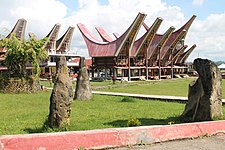
-
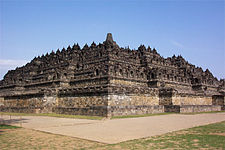
-
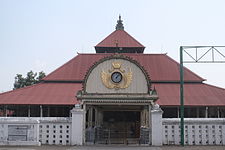
The Tajug or Meru type roof is unremarkably used on sacred buildings in Indonesia, peculiarly Java
-

Crafts [edit]
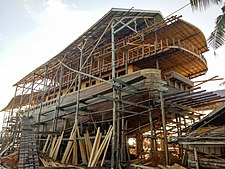
Indonesia is considered as home of earth handicraft.[26] Every ethnic group has its own uniqueness, style, and philosophy of crafting.[26] Most of them are made from wooden, bone, fabric, rock, and paper. These natural materials were crafted using hands into profitable and aesthetic items.[26] Handicraft manufacturing serves non only as an important economical sector, but also a tradition and has a social function equally well.[27] The handicraft industry employs thousands of people in towns and villages across the country. Nearly half a billion dollar worth of handicraft is exported every twelvemonth, and many more is consumed domestically.[26] [27]
There are many varieties of handicraft from other regions.[26] Westward Sumatra and Due south Sumatra are particularly noted for their songket cloths.[28] Villages in the Lesser Sunda Islands produce ikat while provinces in Kalimantan are long known for their basketry and weaving using rattan and other natural fabrics.[29] Wood fine art produced by the Asmat people of Papua is highly valued.[30] Cities along Coffee's northern declension, Cirebon, Pekalongan, and Rembang are known every bit centres of batik.[31] Cirebon and Jepara are important cities in furniture, producing rattan and carved wood respectively,[32] while Tasikmalaya is known for embroidery.[33] Pasuruan also produces furniture and other products and support stores and galleries in Bali.[26] Bandung and Surabaya, both modern, cosmopolitan, and industrialised cities—much similar Jakarta simply on a lesser scale—are creative cities with a diverseness of innovative startups.[26]

A traditional tailor (Tenun) from Sumatra, in the process of sewing
Several Indonesian islands are famous for their batik, ikat and songket cloth. Once on the brink of disappearing, batik and later on ikat, constitute a new lease on life when quondam President Suharto promoted wearing batik shirts on official occasions. In addition to the traditional patterns with their special meanings, used for particular occasions, batik designs accept become artistic and various over the terminal few years.
Other noted Indonesian crafts are Jepara wood carving[34] and Kris. In 2005, UNESCO recognised Kris as one of Masterpiece of the Oral and Intangible Heritage of Humanity from Indonesia.[35]
In 2012, Noken was listed in the UNESCO Intangible Cultural Heritage Lists as a cultural heritage of Indonesia.[36] Women carrying noken are still a common sight in Wamena.[37]
Being the best-known Indonesian sailing-vessel, Phinisi became the tagline for the 2017 inscription of ''The Art of Boatbuilding in South Sulawesi'' in the UNESCO'south Representative List of the Intangible Cultural Heritage of Humanity.
- Some Indonesian Traditional Fabrics
-

-

-
-
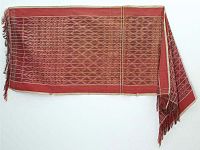
- Some Indonesian Traditional Weapons
-
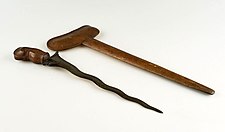
-

-
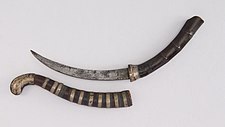
-
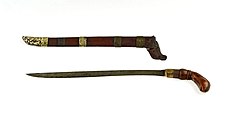
Article of clothing [edit]

Formal family portrait of sometime Indonesian'southward President B.J. Habibie. Women article of clothing kain batik and kebaya with selendang (sash), while men wear jas and dasi (western suit with necktie) with peci cap.
Indonesia'due south best-known national costumes are Batik and kebaya, although initially these costumes originated mainly from Javanese and Balinese civilisation, which are most prominent in Javanese, Sundanese and Balinese cultures. Because Java has get the political centre and population of Indonesia, the isle's folk costume has been raised to national status. As a plural country, Republic of indonesia has 34 provinces, each of which has representatives of traditional clothing from each province with unique and different designs. National costumes are worn at official occasions and traditional ceremonies. each province in Republic of indonesia – more consummate each group in Republic of indonesia, has its own traditional costumes. The costumes of this area are in Indonesian called Pakaian tradisional or Pakaian adat, and are taken from traditional Indonesian textile traditions and crafts.
National costumes [edit]
Batik [edit]

Batik is a cloth that is traditionally made using a transmission wax-resist dyeing technique to form intricate patterns. Traditionally batik cloth is a big piece of intricately decorated cloth used by Javanese women equally kemben or torso wrap. Batik cloth was wrapped around the hips with multiple folds in front called wiron, while the upper body wear kebaya fitted dress. Traditionally for men, the border of batik material also can be sewn together to make a tubular cloth as sarong, or wrapped effectually hips as kain in a fashion similar to women's. Later on for men, the batik cloth also is sewn and made into contemporary batik men's shirt. Today, Batik shirts, which are commonly worn by men in Indonesia (especially in Java), are usually worn during formal occasions; such equally attention weddings, traditional ceremonies, formal meetings, communal gatherings, etc. Batik is recognized every bit one of the important identity of Indonesian culture. UNESCO designated Indonesian batik as a Masterpiece of Oral and Intangible Heritage of Humanity on ii Oct 2009.[38]
Kebaya [edit]
The kebaya is the national costume of women from Indonesia, although it is more accurately endemic to the Javanese, Sundanese and Balinese peoples. It is sometimes made from sheer textile such as silk, sparse cotton wool or semi-transparent nylon or polyester, adorned with brocade or floral pattern embroidery. Kebaya usually worn with a sarong or batik kain panjang, or other traditional woven garment such as ikat, songket with a colorful motif. Kebaya is unremarkably worn during official national events by Indonesian showtime lady, wives of Indonesian diplomats, and Indonesian ladies. It also worn past Indonesian ladies attending traditional ceremonies and weddings. During Balinese traditional ceremonies, Balinese women wore colorful Balinese style kebaya with songket Bali.
Peci [edit]
The Peci, besides known as songkok or kopiah, is a cap traditionally worn by male Muslims in the Indonesian archipelago. Information technology is quite similar to the Turkish-Egyptian fez. In Indonesia, the black velvet peci has become the national headdress with nationalist connotations made pop by Sukarno.[39] A number of Indonesian nationalist movement activists in the early on 20th century, wore a peci to convey their nationalistic sentiments and to demonstrate their Indonesian identity. Indonesian male presidents ever wear a peci as part of their official presidential attire. Since then, the black velvet peci is canonical to exist the national caput-dress for Indonesian men. Information technology is worn all over Indonesia, particularly by government officials and men (usually Muslim men) throughout the country. The peci is usually worn with a batik shirt or western-style suits by men in Indonesia for those attending formal occasions.
- Some traditional clothes in Indonesia
-

Dayak traditional clothes
-

Osing traditional clothes
Foods [edit]

In 2011 an online poll by 35,000 people held by CNN International chose Rendang as the number 1 dish of their 'World'south 50 Nearly Delicious Foods' list.
The cuisine of indonesia has been influenced by Chinese civilization and Indian culture, also as by Western civilization. Notwithstanding, in return, Indonesian cuisine has also contributed to the cuisines of neighbouring countries, notably Malaysia and Singapore, where Padang or Minangkabau cuisine from West Sumatra is very popular. As well, Satay (Sate in Indonesian), which originated from Java, Madura, and Sumatra, has gained popularity as a street vendor food from Singapore to Thailand. In the 15th century, both the Portuguese and Arab traders arrived in Indonesia with the intention of trading for pepper and other spices. During the colonial era, immigrants from many countries arrived in Republic of indonesia and brought different cultures as well every bit cuisines.
Most native Indonesians swallow rice every bit the chief dish, with a wide range of vegetables and meat as side dishes. Notwithstanding, in some parts of the country, such equally Irian Jaya and Ambon, the bulk of the people swallow sago (a blazon of tapioca) and sugariness potato.
The most important aspect of modern Indonesian cuisine is that food must be halal, befitting to Islamic food laws. Haraam, the opposite of halal, includes pork and alcohol. Nevertheless, in some regions where there is a pregnant not-Muslim population, non-halal foods are also commonly served.

Indonesian dishes are usually spicy, using a wide range of chilli peppers and spices. The about popular dishes include nasi goreng (fried rice), Satay, Nasi Padang (a dish of Minangkabau) and soy-based dishes, such equally tofu and tempe. A unique characteristic of some Indonesian food is the application of spicy peanut sauce in their dishes, as a dressing for Gado-gado or Karedok (Indonesian style salad), or for seasoning grilled craven satay. Another unique aspect of Indonesian cuisine is using terasi or belacan, a pungent shrimp paste in dishes of sambal oelek (hot pungent chilli sauce). The sprinkling of fried shallots likewise gives a uniquely crisp texture to some Indonesian dishes.
Chinese and Indian cultures have influenced the serving of food and the types of spices used. It is very mutual to discover Chinese food in Indonesia such as Dim Sum and noodles, and Indian cuisine such equally Tandoori chicken. In addition, Western civilisation has significantly contributed to the all-encompassing range of dishes. However, the dishes have been transformed to conform Indonesian tastes. For instance, steaks are usually served with rice. Popular fast foods such equally Kentucky Fried Chicken are served with rice instead of bread and sambal (spicy sauce) instead of ketchup. Some Indonesian foods accept been adopted by the Dutch, like Indonesian rice table or 'rijsttafel'.
- Some national dishes of Indonesia
-
-
-
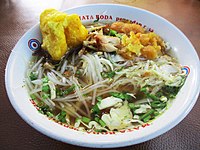
-

Mythology and folklores [edit]

The mythology of Republic of indonesia is very diverse, the Indonesian people consisting of hundreds of indigenous groups, each with their own myths and legends. The stories within this organisation of lore often comprise supernatural entities and magical creatures which form parts of Indonesian mythology. Others relate to creation myths and identify naming legends that are often intertwined with historical figures and events. Ancient rituals for healing and traditional medicine as well as complex philosophies regarding wellness and disease can likewise be institute.
These native mythologies are relatively free from foreign influences, such as Torajans, Nias, Bataks, Dayaks and Papuans. By dissimilarity, Javanese, Balinese, and to some caste Sundanese were influenced by Hindu-Buddhist Indian mythology as early on as the 1st century CE. Hindu gods, legends and epics such as Ramayana and Mahabharata were adopted and adapted into a uniquely local course.
Hindu-Buddhist mythical beings have a function in Javanese and Balinese mythology, including Hindu gods and heroes, devatas, asuras, apsaras (known as hapsari or bidadari), kinnaras, etc., while native gods of nature such as Semar, Dewi Sri, and Nyai Loro Kidul are either given identified as their Hindu counterpart or incorporated into a Java-Bali Hindu pantheon unknown in Republic of india. For case, native rice goddess Dewi Sri is identified with Lakshmi the shakti of Vishnu, and Semar and his sons the Punakawans are incorporated into the ballsy of Mahabharata in Javanese wayang kulit, as the clown servants of the Pandawas. Several names refer to gods, such as Dewa (devas), Dewi (devi), dewata (devatas), and in native traditions unremarkably referred to as Batara (male god) and Batari (female person goddess).
After the coming of Islam to the Indonesian archipelago, Islamic mythology especially those dealing with spiritual beings, such as devils, demons, jinns and angels entered Indonesian mythology. In Sumatra, Malay, Aceh and Minangkabau mythology was almost entirely supplanted by Islamic mythology. However, belief in local spirits such equally the forest guardian, the ghost of water or haunted places all the same exists, often associated with a jinn or the tormented soul of a deceased man.
- Some mythological creatures in Indonesia
-

-
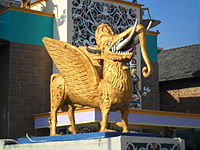
-
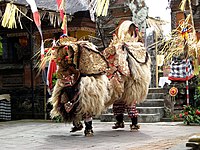
-
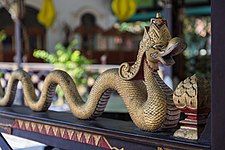
Literature [edit]

Early Indonesian literature originates in Malay literature, and the influence of these roots was felt until well into the twentieth century. The phrase "Indonesian literature" refers to Indonesian as written in the nation of Indonesia, merely also covers literature written in an earlier form of the language, i.due east. the Malay language written in the Dutch East Indies. Pramoedya Ananta Toer was Indonesia'due south nearly internationally celebrated author, having won the Magsaysay Award likewise every bit being considered for the Nobel Prize in Literature. Other important figures include the late Chairil Anwar, a poet and fellow member of the "Generation 45" grouping of authors who were active in the Indonesian independence move. Tight data controls during Suharto'due south presidency suppressed new writing, especially because of its ability to agitate for social reform.
In the book Max Havelaar, Dutch writer Multatuli criticised the Dutch treatment of the Indonesians, which gained him international attention.
Modern Indonesian authors include Seno Gumira Adjidarma, Andrea Hirata, Habiburrahman El Shirazy, Ayu Utami, Gus tf Sakai, Eka Kurniawan, Ratih Kumala, Dee, Oka Rusmini. Some of their works take translated to other languages.
Poesy has a long tradition in Indonesia, especially among ethnically Malay populations, of extemporary, interactive, oral composition of poetry. These poems are referred to as pantun. Contemporary Indonesian poets include among others, Sutardji Calzoum Bachri, Rendra, Taufiq Ismail, Afrizal Malna, Binhad Nurrohmat, Joko Pinurbo, Sapardi Djoko Damono. In written poetry and prose, a number of traditional forms dominate, mainly: syair (traditional narrative poesy), gurindam (brief aphorisms), hikayat (stories, fairy-tales, animal fables, chronicles), babad (histories or chronicles).
On 15 December 2020 the Pantun is recognized as a Masterpiece of the Oral and Intangible Heritage of Humanity past UNESCO (Un Educational, Scientific and Cultural Organization).
Recreation and sports [edit]
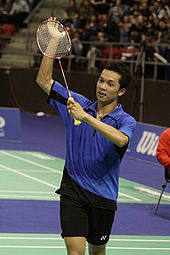
Taufik Hidayat, 2004 Olympic golden medalist in badminton men'south singles.
Many traditional games are notwithstanding preserved and popular in Indonesia, although western culture has influenced some parts of them. Among three hundred officially recognised Indonesian cultures, in that location are many kinds of traditional games: cockfighting in Bali, annual bull races in Madura, and rock jumping in Nias. Stone jumping involves leaping over a stone wall nearly up to 1.5 thousand high and was originally used to train warriors. Pencak Silat is another popular form of sport, which was influenced by Asian culture as a whole. Another form of national sport is sepak takraw.[40] The rules are similar to volleyball: to keep the rattan brawl in the air with the players' feet.
Pop modern sports in Republic of indonesia played at the international level include football (soccer), badminton and basketball.[41] Badminton is one of Republic of indonesia's about successful sports. Indonesian badminton athletes take played in Republic of indonesia Open Badminton Championship, All England Open Badminton Championships, and many international events, including the Summer Olympics and won Olympic gold medals since badminton was made an Olympic sport in 1992. Rudy Hartono is a legendary Indonesian badminton role player, who won All England titles seven times in a row (1968 through 1974). Indonesian teams accept won the Thomas Cup (men'southward globe team title) 13 of the 20-ii times that it has been contested since they entered the series in 1957.[42] In the internationally popular sport of football game (soccer), Indonesian teams accept been active in the Asian Football Confederation (AFC).
Sporting events in Republic of indonesia are organised by the Indonesian National Sports Committee (KONI). The committee, along with the government of Indonesia, has set a National Sports Twenty-four hour period every 9 September with "Sports for All" as the motto. Indonesia has hosted the Southeast Asian Games four times, in 1979, 1987, 1997 and 2011, and won the overall champion title in each of these years. As of 2011, Republic of indonesia has won champion titles 10 times overall out of 18 Ocean Games it has attended since debuted in 1977. The country as well hosted the 1993 Asian Basketball Title.[43] Besides that, it has also hosted the Asian Games twice, the 1962 Asian Games and the 2018 Asian Games.
- Some Indonesian Traditional Sports
-
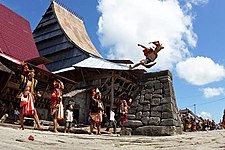
-

-
-

Popular media [edit]
Cinema [edit]
The largest concatenation of cinemas in Republic of indonesia is 21 Cineplex, which has cinemas spread throughout twenty-4 cities on the major islands of Indonesia. Many smaller independent cinemas also be.
In the 1980s, the flick industry in Indonesia was at its elevation, and dominated the cinemas in Indonesia with movies that have retained a high reputation, such as Catatan Si Boy and Blok K and actors like Onky Alexander, Meriam Bellina, Nike Ardilla and Paramitha Rusady.[44] The moving picture Tjoet Nja' Dhien (1988) winning nine Citra Awards at the 1988 Indonesian Film Festival.[45] [ full commendation needed ] It was also the first Indonesian movie chosen for screening at the Cannes Film Festival,[45] [ full citation needed ] where it was awarded All-time International Film in 1989.[46] [ full commendation needed ] Nonetheless, the flick manufacture failed to continue its successes in the 1990s, when the number of movies produced decreased significantly, from 115 movies in 1990 to merely 37 in 1993.[47] As a outcome, most movies produced in the 1990s independent adult themes. The industry started to recover in the tardily 1990s, with the rise of independent directors and many new movies produced, such as Garin Nugroho'south Cinta dalam Sepotong Roti, Riri Riza and Mira Lesmana's Petualangan Sherina and Arisan! by Nia Dinata.[44] Some other form of recovery is the re-establishment of the Indonesian Moving picture Festival (FFI), inactive for twelve years, and the creation of the Jakarta International Motion-picture show Festival. Daun di Atas Bantal (1998) received Asia Pacific Film Festival in Taipei.[48]
Television [edit]
Radio [edit]
The land radio network Radio Republik Indonesia (RRI) was founded in 1945. It consists of a network of regional stations located in all thirty-three provinces of the archipelago. In most cities and large towns there are besides many commercial stations. Since 2006, several digital radio stations have been based in Dki jakarta and Surabaya, using Digital Audio Broadcasting (DAB) and Hybrid HD-Radio.[49] [50] [51]
Religion and philosophy [edit]
Islam is Indonesia'due south main organized religion, with almost 88% of Indonesians declared Muslim according to the 2000 census,[52] making Republic of indonesia the almost populous Muslim-majority nation in the globe. The remaining population is 9% Christian (of which roughly 2-thirds are Protestant with the balance mainly Catholic, and a big minority Charismatic), 2% Hindu, and one% Buddhist.
The Pancasila, the argument of two principles that encapsulate the ideology of the Indonesian country, affirms that "The state shall be based on the belief in the 1 and only God".
- Some Indonesian ritual worship
-

Maudu Lompoa tradition in Sulawesi, to commemorate the birthday of the prophet Muhammad
-

Labuhan procession in Yogyakarta is believed to help preserve the residue of nature
Celebrations [edit]
| Appointment (Gregorian Calendar) | Date (Religious Agenda) | English Name | Local Name | Remarks |
|---|---|---|---|---|
| ane January | New year | Tahun Baru Masehi | ||
| Rabi' al-awwal 12 | Nascence of the Prophet | Maulid Nabi Muhammad | Altogether of the Islamic Prophet Muhammad | |
| January–February | Chinese New Twelvemonth | Tahun Baru Imlek | 1st day of 1st calendar month of Chinese Agenda | |
| March | Kasa 1 Pawukon forty | Day of Silence | Hari Raya Nyepi (Tahun Baru Saka) | New Twelvemonth of Balinese agenda |
| March–Apr | Practiced Fri | Wafat Yesus Kristus/Isa Almasih (Jumat Agung) | Appointment varies; this is the Friday before Easter Sun, which is the beginning Sunday after the get-go Paschal Full Moon following the official vernal equinox | |
| i May | Labour Day | Hari Buruh | ||
| May–June | Ascension of Jesus Christ | Kenaikan Yesus Kristus/Isa Almasih | ||
| May | Every May of Vaisakha | Buddha'due south Birthday | Waisak | In Indonesia information technology is celebrated every bit Trisuci Waisak, to commemorate three of import events in Buddhism; Buddha'south birthday, enlightenment and his death. The engagement varies according to the Buddhist agenda |
| Rajab 27 | Ascension of the Prophet | Isra Mi'raj Nabi Muhammad | ||
| one June | Pancasila Day | Hari Lahir Pancasila | Public vacation since 2016, marks the appointment of Sukarno's 1945 address on the national credo | |
| 17 Baronial | Independence Twenty-four hour period | Hari Proklamasi Kemerdekaan R.I. | Sukarno and Mohammad Hatta every bit the proclaimers | |
| Shawwal 1–2 | Mean solar day afterwards Ramadan | Idul Fitri (Lebaran Mudik) | Date varies according to the Islamic agenda | |
| Dhu al-Hijjah 10 | Feast of the Cede | Idul Adha (Lebaran Haji) | Date varies according to the Islamic calendar | |
| Muharram 1 | Islamic New year | Tahun Baru Hijriyah | 1st day of the Muharram, the beginning of the new Islamic twelvemonth | |
| 25 Dec | Christmas | Hari Natal |
Encounter also [edit]
- Demographics of Indonesia
- List of museums and cultural institutions in Indonesia
- National Intangible Cultural Heritage of Indonesia
References [edit]
- ^ Taylor, Jean Gelman (2003). Indonesia peoples and Histories. ISBN0-300-10518-5.
- ^ "Indonesian Angklung". Unesco.org . Retrieved 21 Baronial 2017.
- ^ "UNESCO grants Republic of indonesia's angklung cultural heritage title". News.xinhuanet.com. Archived from the original on 8 July 2013. Retrieved 21 Baronial 2017.
- ^ "Archived copy". Archived from the original on 4 Apr 2011. Retrieved 4 April 2011.
{{cite spider web}}: CS1 maint: archived re-create as title (link) - ^ "Traditional dances, crafts, noesis and music on the agenda at Intangible Heritage Committee coming together in Namibia". UNESCO . Retrieved i Dec 2015.
- ^ "Traditional dances proposed to be world'southward heritage". The Dki jakarta Postal service. 16 November 2011. Retrieved 1 December 2015.
- ^ ""Saman dance", Inscribed in 2011 (half-dozen.COM) on the List of Intangible Cultural Heritage in Need of Urgent Safeguarding List". UNESCO. Retrieved x October 2014.
- ^ "UNESCO officially recognizes Saman Trip the light fantastic every bit part of intangible cultural heritage, UNESCO". 24 Nov 2011. Archived from the original on 27 November 2011.
- ^ "nine Properti Tari Saman (Lengkap beserta gambar dan deskripsi)".
- ^ Ness, Edward C. Van; Prawirohardjo, Shita (1980). Javanese Wayang Kulit: An Introduction. Oxford University Press. ISBN9780195804140.
- ^ Miyao, J. (1977). "P. L. Amin Sweeney and Akira Goto (ed.) An International Seminar on the Shadow Plays of Asia". Southeast Asia: History and Culture. Japan Club for Southeast Asian Studies (7): 142–146. doi:10.5512/sea.1977.142.
- ^ ""Wayang puppet theatre", Inscribed in 2008 (3.COM) on the Representative Listing of the Intangible Cultural Heritage of Humanity (originally proclaimed in 2003)". UNESCO. Retrieved x Oct 2014.
- ^ Yves Bonnefoy (1993). Asian Mythologies. University of Chicago Press. p. 162. ISBN978-0-226-06456-seven.
- ^ Donn F. Draeger (1992). Weapons and fighting arts of Indonesia. Rutland, Vt. : Charles Eastward. Tuttle Co. ISBN978-0-8048-1716-five.
- ^ "'Pencak silat' given UNESCO intangible earth heritage distinction". The Jakarta Postal service . Retrieved 13 December 2019.
- ^ Donn F. Draeger (1992). Weapons and fighting arts of Indonesia. Rutland, Vt. : Charles E. Tuttle Co. ISBN978-0-8048-1716-5.
- ^ M. Aubert et al., "Pleistocene cavern art from Sulawesi, Indonesia", Nature volume 514, pages 223–227 (9 October 2014). "using uranium-series dating of coralloid speleothems directly associated with 12 human paw stencils and ii figurative animal depictions from seven cave sites in the Maros karsts of Sulawesi, we show that rock art traditions on this Indonesian island are at least compatible in age with the oldest European art. The earliest dated image from Maros, with a minimum age of 39.9 kyr, is now the oldest known hand stencil in the earth. In addition, a painting of a babirusa ('sus scrofa deer) made at least 35.4 kyr ago is amid the earliest dated figurative depictions worldwide, if non the earliest one. Among the implications, it tin can now be demonstrated that humans were producing rock art past ~40 kyr ago at opposite ends of the Pleistocene Eurasian world."
- ^ Aubert, M.; et al. (11 December 2019). "Primeval hunting scene in prehistoric fine art". Nature. 576 (7787): 442–445. doi:10.1038/s41586-019-1806-y. PMID 31827284. S2CID 209311825.
- ^ Ferreira, Becky (11 December 2019). "Mythical Beings May Exist Earliest Imaginative Cave Art by Humans - The paintings on an Indonesian isle are at least 43,900 years old and depict humanoid figures with animal-similar features in a hunting scene". The New York Times . Retrieved 12 Dec 2019.
- ^ Hilda Soemantri, ed. Indonesian Heritage: Visual Art. Singapore: Didier Millet, 1998: p. 45-49.
- ^ Hilda Soemantri, ed. Indonesian Heritage: Visual Art. Singapore: Didier Millet, 1998: p. 50-59
- ^ Astri Wright, Soul, Spirit and Mount, Preoccupations of Contemporary Indonesian Painters, Oxford University Press, 1994.
- ^ Reif, Rita (5 August 1990). "ANTIQUES; Bronze Treasures From Indonesia". The New York Times. ISSN 0362-4331. Retrieved 15 Nov 2021.
- ^ Cockrem, Tom (18 May 2008). "Temple of enlightenment". The Sydney Morning Herald . Retrieved 11 November 2011 – via The Buddhist Channel.tv.
- ^ "Borobudur : A Wonder of Indonesian History". Republic of indonesia Travel. Archived from the original on 14 Apr 2012. Retrieved 5 April 2012.
- ^ a b c d e f one thousand "Indonesia's Remarkable Handicraft" (PDF). Indonesian Ministry of Merchandise. February 2016. Archived (PDF) from the original on 10 October 2017. Retrieved 10 October 2017.
- ^ a b Barber, Ted; Krivoshlykova, Marina (July 2016). "Global Market Assessments of Handicrafts" (PDF). USAID. Archived (PDF) from the original on 27 December 2016. Retrieved 27 December 2016.
- ^ Sanday, Peggy R.; Kartiwa, Suwati (August 1984). "Cloth and Custom in W Sumatra: The Codified of Minangkabau Worldview". Penn Museum. Archived from the original on 21 December 2016. Retrieved 21 Dec 2016.
- ^ "Indonesian Endless-Handbasket Inventiveness" (PDF). Indonesian Ministry of Merchandise. eight December 2012. Archived (PDF) from the original on 10 Oct 2017. Retrieved 10 October 2017.
- ^ Andersen, Øystein L. (March 2006). "Babrongko, Material culture of a Lake Sentani Hamlet" (PDF). Cenderawashi Academy. Archived (PDF) from the original on 10 October 2017. Retrieved 10 October 2017.
- ^ Situngkir, Hokky (August 2009). "The Phylomemetics of Batik" (PDF). Archived (PDF) from the original on 10 May 2017. Retrieved x May 2017.
- ^ Puntodewo, Atie; Melati; Achdiawan, Ramadhani; Irawati, Rika Harini; Purnomo, Herry. "Jepara Article of furniture: Tourist map and shopping guide" (PDF). Archived (PDF) from the original on x October 2017. Retrieved x October 2017.
- ^ "Indonesian Embroidery: The Elegant Motifs" (PDF). Indonesian Ministry of Trade. 8 Dec 2012. Archived (PDF) from the original on 27 Dec 2016. Retrieved 27 December 2016.
- ^ "High Quality Jepara Woodcarving". 1 November 2010. Archived from the original on ane November 2010. Retrieved 21 Baronial 2017.
{{cite web}}: CS1 maint: bot: original URL condition unknown (link) - ^ "Intangible Heritage Domicile – intangible heritage – Culture Sector – UNESCO". Unesco.org . Retrieved 21 Baronial 2017.
- ^ ""Noken multifunctional knotted or woven pocketbook, handcraft of the people of Papua", Inscribed in 2012 (7.COM) on the Listing of Intangible Cultural Heritage in Demand of Urgent Safeguarding". UNESCO. Retrieved 10 October 2014.
- ^ Nethy Dharma Somba (26 September 2011). "Transforming Wamena into Papua'due south tourism icon". The Dki jakarta Post. Archived from the original on x May 2013. Retrieved fifteen March 2013.
- ^ Indonesian Batik Inscribed in 2009 on the Representative List of the Intangible Cultural Heritage of Humanity
- ^ Yusep Hendarsyah (28 April 2011). "Peci Hitam dan Identitas Paling Indonesia". Kompasiana. Archived from the original on 12 August 2012. Retrieved 28 March 2012.
- ^ "Gajah Emas Game History – Sepak Raga Archived 24 November 2007 at the Wayback Automobile"
- ^ "94Fifty Announces Distribution Partner for Republic of indonesia – Exclusive distributor of 94Fifty Basketball skill applied science named for growing basketball game market. Archived 21 December 2011 at the Wayback Automobile"
- ^ Great britain on-line: sport Archived 2 December 2008 at the Wayback Machine
- ^ "FIBA Asia Contest Archives". Competition Athenaeum. International Basketball game Federation FIBA. 26 September 2011. Retrieved fifteen Apr 2012.
- ^ a b Kompas "Archived copy". Archived from the original on 13 Jan 2008. Retrieved 31 October 2016.
{{cite web}}: CS1 maint: archived copy as title (link) - ^ a b Monash 2007-08-03, Tjoet Nja' Dhien. sfn error: no target: CITEREFMonash_2007-08-03,_Tjoet_Nja'_Dhien (assistance)
- ^ Siapno 2006, p. 25. sfn error: no target: CITEREFSiapno2006 (help)
- ^ "Kondisi Perfilman di Indonesia". Webcitation.org. Archived from the original on 23 October 2009. Retrieved 21 Baronial 2017.
- ^ "Asia-Pacific Flick Festival". IMDb.com . Retrieved 21 August 2017.
- ^ "Archived copy". Archived from the original on 26 June 2010. Retrieved fifteen September 2010.
{{cite web}}: CS1 maint: archived copy equally title (link) - ^ "Archived re-create". Archived from the original on xv July 2011. Retrieved 15 September 2010.
{{cite spider web}}: CS1 maint: archived copy as championship (link) - ^ "Archived re-create". Archived from the original on 11 March 2016. Retrieved 15 September 2010.
{{cite web}}: CS1 maint: archived copy as title (link) - ^ "The World Factbook – Central Intelligence Agency". Cia.gov . Retrieved 21 August 2017.
Farther reading [edit]
- Kuncaraningrat. (1985) Javanese civilization Singapore: Oxford University Press,
- Kathleen M. Adams (2006). Art equally Politics: Re-crafting Identities, Tourism and Power in Tana Toraja, Republic of indonesia. Honolulu: Academy of Hawaii Press. ISBN978-0-8248-3072-4.
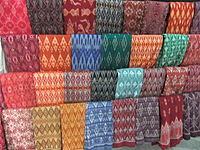

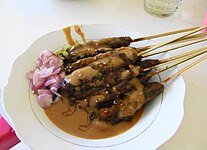

0 Response to "Ab75 Late 1960s San Francisco Politics Arts and Culture Full Film"
Post a Comment